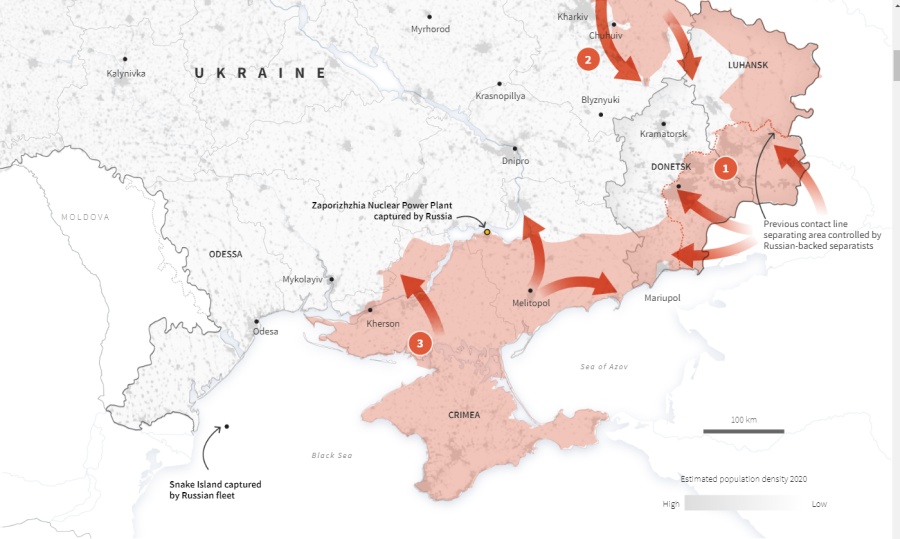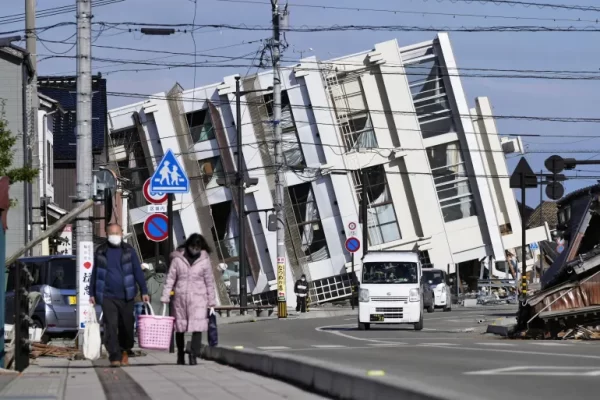How Putin’s Invasion is Changing Society as We Know It.
In the early hours of February 24th. 2022, the morning erupted with the sound of cruise missiles and artillery barrages. Russian armed forces initiated their full-scale invasion of Ukraine. Prompting the most significant military conflict between two nation-states in Europe since World War II. The bombing of airports, hospitals, and many military sites took place. Over 200,000 Russian troops and their ammunition, tanks, and planes crossed the Ukrainian border. Along three different fronts. In the weeks since the world as we knew it before has been forever and irreversibly changed in countless ways. As Vladimir Lenin once said, “There are decades where nothing happens; and there are weeks where decades happen.”
While the Russian invasion will certainly have numerous consequences that will be felt by nearly every single country around the world, it’s obvious that none will experience more severe consequences than Ukraine itself. Since they’re currently being invaded, shelled, besieged, and destroyed as of the moment this story is being written. Their nation is the one whose very existence Vladimir Putin has now openly called into question. Since over two months ago, it has no doubt been horrendous. Ukraine will experience reverberations of this trauma for generations to come and from the perspective of the Kremlin, the invasion is not going according to plan. Putin and the Russian military clearly underestimated the ferocity of Ukrainian resistance. While they also place too little emphasis on their own coordination and supply chains. The conflict is dragging on longer now than they initially anticipated. This is an extremely dangerous situation because, with western sanctions, the Russian military is in a race against the clock before the Russian economy completely collapses. To make an attempt to force a surrender faster, Russia may begin utilizing even more of its destructive and indiscriminate firepower. Such as concentrated artillery or air power. Which they so far have been holding back, and when that happens, the destruction and refugee crisis in Europe since World War II will only continue. As it stands now while authoring this story, more than 2.5 million Ukrainians which have consisted of mostly women and children, have been forced to flee the country as refugees westward to Poland, Hungary, Slovakia, Romania, and Moldova. If this war leads to a protractive conflict, The United Nations has estimated that there could be as many as 10 million refugees fleeing Ukraine. This will be enormously catastrophic for the rest of Europe, to say the least. To put this into perspective, during 2015 when Europe was undergoing the so-called migrant crisis from the middle east and north Africa, the continent saw 1.3 million refugees coming in over the entire year. There have now been near twice as many Ukrainian refugees as that in a matter of weeks. While refugees have been leaving equipment, supplies, and weapons, thousands of foreign volunteers have been deployed from several nations around the world to assist and defend Ukraine.
It’s worth noting that we’re over two months into this conflict, and wars are often fought and won over the course of months, or even years. It is still far too early to predict how this war will turn out, to say the least. But should the Kremlin emerge victoriously, it has the potential to completely upend the entire border of Europe. With the flurry of sanctions, travel bans, airspace restrictions, mass arrests within Russia, and even more to come. A new iron curtain is descending across the continent of Europe. This time, shifted over slightly to the east from where it was before from Kaliningrad to Ukrainian shores. It is beginning to appear that the Cold War in Europe between the West and Moscow was once believed to have ended for good back in 1991 when people like Francis Fukuyama unilaterally declared the end of history. Merely instead, took a 30-year break and has now once again returned. This is manifold and all around us historically neutral. Recent polls in both Sweden and Finland have shown that much of the population in both countries is now in favor of joining the NATO alliance. As both governments have expressed some form of interest.
Finland’s admittance into the alliance has particularly been controversial. Owing to their large land border with Russia and their proximity to Saint Petersburg, Russia’s second-largest city, and the hometown of Vladimir Putin. For decades during the Cold War’s first phase, the Soviet Union pressured Finland into always staying neutral between the east and west. It seems as if old habits die hard. But among the greatest of changes ushered in by Putin’s war in Ukraine is the revolution undergoing in Germany. Specifically, the German military and defense doctrine. During a session of the German Bundestag, just three days after the invasion, the new chancellor Olaf Schultz announced a series of measures. The German armed forces would receive a one-time $113 billion defense fund to modernize themselves. This means that their yearly budget will be increased by $78 billion. This will lead to Germany’s military suddenly becoming the third best-funded in the world. Only behind China and the United States. Critically that means they’ll be ahead of Russia’s military budget. The German army will rapidly once again for the first time in nearly a century take over the reins of being the most formidable in the European continent. The geopolitical revolution goes even further. Germany has also agreed to send lethal aid to Ukraine and most unexpectedly of all, they’ve agreed to indefinitely suspend the Nordstrom 2 Pipeline Project that would have brought in even more enormous quantities of natural gas directly from the vast sources of Siberia and Russia. The cost to build this controversial pipeline was more than $11 billion. Of course, such a move will be difficult for the German economy to bear. But such is their resolve in showing solidarity with Ukraine. This is all quite unexpected and unprecedented because right up until the invasion took place, Germany was hesitant to support Ukraine and oppose Russia. The reason being is that Germany is critically over-dependent on Russian natural gas. Even without the Nordstrom Pipeline with limited domestic energy resources of its own, Germany has had no other choice but to import the entirety of its energy needs from abroad. With some of the largest natural gas and oil reserves in the world, geographically nearby Russia has always been the most significant provider through a complex series of pipelines that have been constructed over decades sprawling out from the vast oil and gas fields in Siberia.
Russia directly provides Germany with a third of oil and half of their natural gas, and the same applies to much of the rest of Europe. Italy and France also import significant amounts of Russian fossil fuels, and the closer eastwards the countries are to Moscow the more fossil fuels are imported. To the point where many nations such as Bosnia, North Macedonia, Moldova, Finland, Estonia, Latvia, Bulgaria, Slovakia, Croatia, Czechia, and Austria import nearly the entirety of their gas from Russia. This is geological because the European continent is not composed of substantial amounts of oil or natural gas that power the modern engines of civilization. Instead, substantial amounts of these resources can be found all around the European Union’s perimeter in the North Sea between the United Kingdom and Norway across the Euro Mountains in Russian Siberia. In the eastern Mediterranean around Cyprus Israel, Egypt, and near the Persian Gulf. With critically few oil and gas resources themselves, the European Union is therefore critically dependent on the importation of Russian oil and gas from their pipelines.
This severely limits their abilities to directly confront Moscow’s aggression. To overcome this dependency and energy insecurity, the European Commission has since the invasion outlined a 10-point proposal to make the EU completely independent from Russian fossil fuels by the end of the decade. But this will take years to accomplish. Until this happens, every gallon of oil and gas that Europe continues to purchase from Russia will go directly towards funding the Russian war taking place in Ukraine. However, there aren’t any easy alternatives for Europe. Norway, the second largest provider of gas to the European Union, is already at maximum export capacity through its pipelines. Meaning they cannot provide any more than they already are. in theory, the EU could replace some of Russia’s gas with liquefied natural gas or LNG imports coming in on tanker ships from friendly countries such as the United States Qatar, or Australia. However, there are many problems with this strategy. First, Europe lacks a lot of the infrastructure that’s required for importing LNG. To do so, they need LNG processing terminals at ports they can take in the LNG from. container ships, turn the liquid back into its gases state and pump that into pipelines. Unfortunately, very few of these LNG terminals exist right now. With only a handful in Portugal, Spain, Italy, France, the United Kingdom, Belgium, the Netherlands, Poland, and Greece. While major global economies like Germany which import more than half of their gas from Russia have none. To begin importing LNG on a large scale, the Germans will have to build new LNG terminals. However, movements like this will cost a lot of money. Additionally, a process like this will take time. Secondly, even if the EU had the infrastructure, the supply chain of LNG is already highly constrained as it is and is met by the massive demand for it in Asian economies. Such as China, South Korea, and Japan. If the EU began purchasing LNG on a large scale, the price would increase dramatically. Although the EU could depend on its domestic resources, this too is highly problematic. To view more information on how Europe imports its energy, click here.
Since the beginning of the war’s outbreak, Ukrainian airspace has been completely sealed off from the rest of the world. As a result, international flights have all been avoiding this conflict. However, just days following the invasion and as part of their overall sanctions package the European Union blocked all Russian airlines from flying over their airspace. Followed up by similar declarations from Norway, Iceland, Canada, and the United States. In retaliation for these blockages, Russia decided to ban the airlines of 36 nations from using their airspace. Including all EU, British Canadian, American, and Japanese airlines. As a result, western airlines have largely stopped flying to Russia. While Russian airlines have done the same. So, while a physical iron curtain has yet to descend back across Europe on the ground, the iron curtain of the air is already very much a new reality again Flight radar maps are right now showing the airspaces of Russia and Europe as being completely separated. With a massive empty nomad zone. Where nobody is flying over at all covering the entirety of Ukraine, Belarus, Moldova, and western Russia. Across the new iron curtain of the sky as the largest country in the world, Russia’s geographic position on the map now represents a colossal barrier to the free flow of western airlines around the world. This represents a massive geographic challenge to fly around for western flights between Europe and East Asia. For example, prior to the war, Air France was operating a route between Paris Charles de Gaulle and Tokyo Narita. Which took them through a substantial amount of Russian airspace. Now, after the ban on using Russian airspace, the airline must start flying a new route to the south that adds 2 hours and 30 minutes more to the total flight time. Although this is just one example, there are plenty more. This once again takes us back to the Cold War era. Back when the Soviet Union denied their entire vast airspace to western airlines. Just as Russia is doing so right now.
Not to even mention the enormous sanctions that western countries are implementing on Russia. Which will have devastating financial impacts on every Russian citizen for years or even decades to come. Further, I haven’t even mentioned the dozens of western companies that have announced their suspension of operations in the Russian economy. Most notably McDonald’s. It was among the very first western companies that were allowed to open in Moscow back in 1990 when it was still a part of the Soviet Union. In the 30 years since then, McDonald’s in Russia has built and developed an incredibly close relationship with around 850 locations across the country that provide around 10 of McDonald’s entire worldwide revenue. However, in a matter of days, Putin’s invasion of Ukraine completely eradicated its relationship with the company which took three decades to build. As McDonald’s announced the closure of all locations in Russia. Several companies then followed. From Adidas, PlayStation, Instagram, Samsung, Microsoft, Nintendo, Visa, UPS, YouTube, and many more. In response, Russia has threatened to nationalize any remaining assets. Essentially turning the page back to the command economy of the Soviet Union.
There’s no telling how the crisis in Ukraine today could affect things like this going forward shortly. However, what is clear now is that wars in the 21st century always have vast global consequences. Putin’s invasion of Ukraine has changed Russia, Ukraine, and the rest of the world in more ways than I could ever convey in 8 pages. But by analyzing how the Kremlin worked during times of war and crisis, we can figure out how this present conflict will escalate. I believe that this conflict is only the latest of several wars initiated by Putin’s regime. As the ferocity and intensity of Russian attacks on the country continue ramping up in scale. The scenes that we’re all seeing every day portrayed by the media are beginning to reflect the very first war that Putin led Russia through more than two decades ago.

My name is Diamond. I just graduated high school and now I'm producing content part-time online. My most popular profile is @BlindOS_22 on TikTok which...













